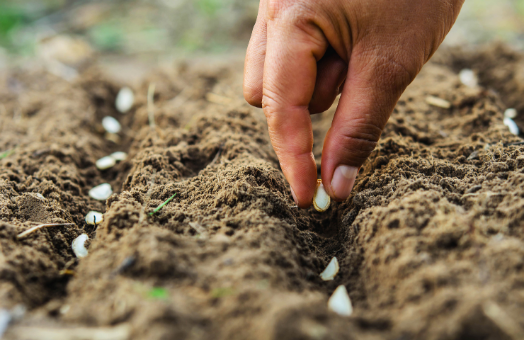GYO share this month's crops to sow and harvest
)
Whilst it might not be the traditional high season for gardening, that doesn't mean everything stops for avid gardeners. Our partners over at Grow Your Own Magazine have broken down the top of the crops for sowing, planting and harvesting in autumn to help you guide your customers to the best plants for their veggie patches this season.
SOW
Broad beans: If you live in a mild area of the UK then you can make sowings of this crop now. In 30 weeks you should be rewarded with tasty pods
Cauliflowers: Sow seeds 2cm deep in a seed bed, allowing 60cm between rows for larger cultivars
Salad crops: Provide protection from frosts by starting seeds under cover if you wish to keep harvesting these productive greens
PLANT
Apples: Be sure to buy a named cultivar from a specialist nursery to avoid potential issues such as harmful diseases
Cherries: Avoid shallow, sandy or badly drained soils for the best chance of success
Currants: New bare-rooted bushes can be planted now, as well as those growing in a container
Garlic: Cloves need a chilling period, so now is an ideal time to get them in the ground. They can also be started off in modules if the ground is too wet to work with
Gooseberries: Choose a sunny position with fertile soil to achieve a bumper crops of this tasty fruit
Nectarines and peaches: Bare-root varieties can be planted from November to March and are best positioned in a sheltered spot, away from potential frost pockets
Pears: Choose a sunny and fertile site with protection from frosts to plant these productive trees Plums: This crop needs a lot of moisture to thrive, so it is best suited to clay or loamy soils Raspberries: Autumn varieties can be planted now, but remember to weed the ground thoroughly before you begin
Rhubarb: This edible doesn't do well in waterlogged soil, so many sure the ground is free-draining before you plant it

HARVEST
Apples: Make sure you have picked all of the fruit from your trees before the end of the month. If kept in suitable conditions they will store well for months
Brussels sprouts: Start harvesting buttons from the base of the plant and work your way upwards
Cabbages: Continue to cut the heads when they grow to a suitable size. Keep netting in place for pest protection
Cauliflowers: Autumn varieties can be cut now. If you keep some of the outer leaves intact then your harvest will stay fresher for longer
Celeriac: This root can be left in the ground if covered with straw or a similar material for frost protection. Lift the yields as and when they are needed
Chicory: Red and sugarloaf types should be taken by the end of the month if they are growing outside
Cranberries: When the fruit turns a deep red colour then it is ready to be hand picked
Grapes: Harvest the fruit by hand when it is fully coloured – this is dependent on variety Jerusalem artichokes: Lift these tubers from the ground this month, being careful not to pierce the skin with a fork
Kale: The large leaves can be taken now, but this plant will continue to flourish even through winter
Kohl rabi: If you sowed this crop in the summer, it may be ready for harvesting now
Leeks: Cut these tasty stems whenever you need them. They store well if left in the ground over winter
Lettuce: Pick these crunchy leaves by cutting them with a sharp knife and enjoy them in winter salads. Cut-and-come-again types will keep rewarding you with leaves through the month
Parsnips: If you want the best flavour from your roots then it is best to leave them through a few frosts before lifting
Pears: Take this fruit just before it is ready as it develops much more successfully when allowed to ripen in a fruit bowl
Radishes: Make successional sowings of this speedy crop and you will be in an abundant supply of peppery roots
Salad leaves: Cut the foliage regularly from this plant and they will reward you with multiple harvests
Swede: Take the roots when they are large enough to use. Use straw for frost protection if you don't plan on using them all at once
Swiss chard: Pick the leaves regularly and protect them with a cloche if colder weather is forecast
Turnips: Once the roots have reached the size of a golf ball then you can start lifting from the middle of this month
